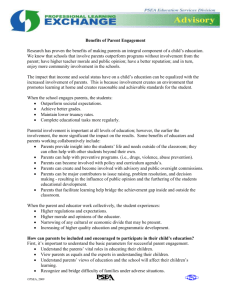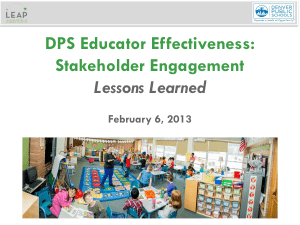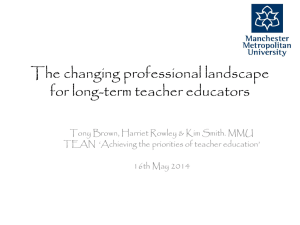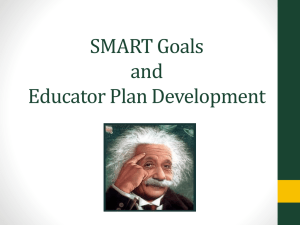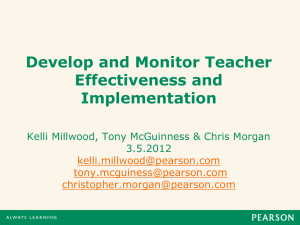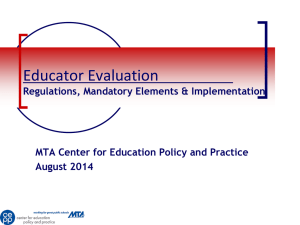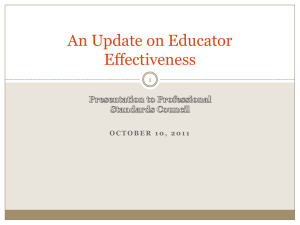Professional Growth Plans - Arkansas Department of Education
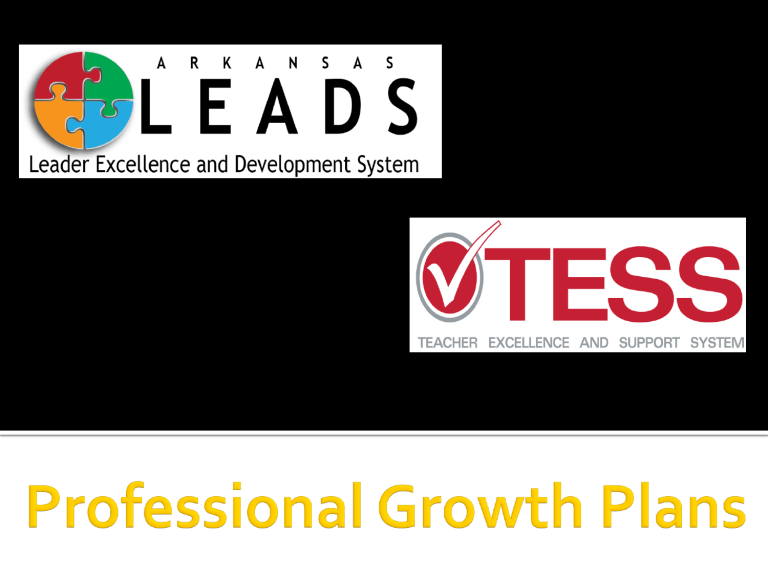
Self-
Motivating
Self-
Monitoring
Learning,
Leading, and
Teaching in the Digital
Age
Self-
Modifying
2
Teachers/principals’ professional growth and performance should have a positive impact on student learning and achievement.
The process should define clear, consistent expectations for all teachers/principals and should support continuous learning.
The process should foster collaboration among the teacher/principal, evaluator, and peers.
The process should be a professional growth experience based on trust and mutual respect.
3
The process should provide multiple ways of developing and documenting skills and knowledge.
The process should provide for differentiation based on teacher support needs and experience.
The process should engage teachers in reflective practice and active involvement in their own professional growth.
4
“Problem of Practice”
• Problem based on data
• Success indicated from data
• Hypothesis for resolving the gap
5
6
Observation Data
Data from Observations/ Evaluations
Self-Assessment Data
Student Achievement Data
National or State Assessment Data (Aggregate and Individual)
District Assessments
Classroom Data (Assessment and Performance)
Anecdotal Data
Records, Logs,
Perceptual Data
Surveys, Responses
Demographic Data
Attendance or Discipline Data
ETC…
7
The roles of educators is varied in school districts
The data that is used to identify a school, grade level, or individual “problem of practice” is as diverse as the varied roles within the school
While a common “problem of practice” may be identified for a school or a group of educators, the goal(s) to improve professional practice and the strategies to achieve the goal will vary depending on an individual educator’s role within the school
Individual educators are encouraged to identify the problem of practice based on data relevant to their respective roles.
8
“Problem of Practice”
• Problem based on data
• Success indicated from data
• Hypothesis for resolving the gap
Choose a goal or action from building ACSIP
9
As the Problem of Practice is identified, educators should consider how the problem of practice connects to a goal or action identified in the school’s improvement plan.
The inclusion of a related ACSIP goal will help the educator to create a PGP goal that will in some way tie in to goals identified in ACSIP and focus on ways to improve educator practice that will ultimately lead to improvement in student achievement.
The manner in which an educator improves professional practice will vary depending on the educator’s experience and needs identified in the PGP and observation ratings.
10
“Problem of Practice”
• Problem based on data
• Success indicated from data
• Hypothesis for resolving the gap
Choose a goal or action from building ACSIP
“The Vision”
Personal Professional Goal(s)—What will I achieve to ensure student growth?
11
Do these goals reflect my own professional learning needs?
After assessing my own professional learning needs, what areas have I chosen to focus on for this school year?
Do these goals reflect the Standards
(CCSS or ACF, ISSLC) and take into consideration my school/system plans?
Are these goals based on student achievement data, discipline data, CWT data, etc.?
Are these goals realistic?
12
Growth is a result of working toward goals.
Specific goals help direct professional development activities and changes in practice.
A goal may be to “learn about cooperative learning”.
A more specific goal would be “to utilize cooperative learning as a teaching and learning approach which impacts achievement”.
13
Meaningful goals:
have substance and meaning for the teacher/principal.
are tied to effect size.
stretch current thinking and practice.
can be achieved and don’t lead to frustration.
have deadlines that help to ensure that the goal is attained.
lead to improved student performance.
14
Related Framework Components that ALIGN with the GOAL. How do my goals align with my evaluation? What does proficient or distinguished performance look like as related to my goal?
“Problem of Practice”
• Problem based on data
• Success indicated from data
• Hypothesis for resolving the gap
Choose a goal or action from building ACSIP
“The Vision”
Personal Professional Goal(s)—What will I achieve to ensure student growth?
15
An effect size [ES] of 0.4 is one year’s growth for one year’s time.
An ES of 1.0 is equivalent to two to three years of growth in one year’s time.
16
S specific and contextual
M meaningful measures
A achievable within resources
R realistic
T time targeted
17
Apply
Implement
Investigate
Maintain
Organize
Pilot
Attend
Conduct
Join
Participate
Publish
Read
Share
Contribute
Discuss
Enroll
Integrate
Mentor
Serve
18
State the Action you will take
Describe an Area of Focus for the Learning
Include the Rationale
Add the Activities (optional)
I will investigate intervention strategies to incorporate Response to Intervention (RTI) processes into my classroom to better differentiate student instruction due to delayed learning by students performing below grade level .
19
State the Action you will take
Describe an Area of Focus for the Learning
Include the Rationale
Add the Activities (optional)
Because the number of teacher and student absences has increased by 10% during the last 3 years , I will seek strategies to reduce the rate of absences school-wide .
In collaboration with a variety of stakeholders, I will seek to find the causes for the increased absenteeism and utilize research to find ways to decrease the number of days of missed instruction.
20
State the Action you will take
Describe an Area of Focus for the Learning
Include the Rationale
Add the Activities (optional)
Because I am a science teacher and need new approaches to helping my non-readers, I will learn about research-based strategies to improve student learning in reading comprehension . I will incorporate new strategies into my daily instructional practices . Student achievement will increase in reading comprehension as a result of focused instruction.
21
State the Action you will take
Describe an Area of Focus for the Learning
Include the Rationale
Add the Activities (optional)
The goal of this plan is to eliminate the need for college remediation by consistently evaluating student progress on college-entrance exams in collaboration with students, parents, and community stakeholders. The goal will be to improve our school’s ACT averages, reduce remediation rates and improve rates of post-secondary institution enrollment.
Through a partnership between the high school and local 2-year college, students will be provided with opportunities for ACT preparation through throughout the year designed to increase overall scores and target areas of high remediation rates and also to provide early access to non-credit bearing college-courses for students who require them.
22
Individually Guided
Personal study
Web-based learning
Anecdotal records
Reflective journals
Individual action research
Log entries
Cooperatively Guided
Project-based
School visits
Assessment instruments (surveys, questionnaires)
Authentic teacher made materials
(designing quality work for students)
23
Instruction/Workshops
Technology skill training
Workshops
Conference
Observation/Assessment
Peer coaching (peer-to-
peer)
Cognitive coaching
(peer-admin)
Videotaped lessons
Team teaching
Inquiry
Group action research
Data collection and analysis
Study group
24
What activities will I use to reach my goal?
How will I achieve my desired outcomes?
25
“The Plan”
Strategies—How will I achieve my goal(s)?
“The Proof Indicators”
How will I know I have achieved my goal(s)?
“The Proof Indicators”
How will I know I have achieved my goal(s)?
“The Proof Evidence”
What data or information will help me to reflect on the achievement of my goal?
“The Proof Evidence”
What data or information will help me to reflect on the achievement of my goal?
26
What will success look like when I reach my goal?
What do I want to achieve as a result of this goal and what difference will it make in student learning and achievement results?
How will I collect evidence of my professional growth?
27
“The Support Resources” What do I have and what do I need to achieve my goal(s)?
“The Support Timeline” What are my activities and when will they occur as I achieve my goal(s)?
28
• What assistance and supports are available to me?
• What expertise is available from my colleagues?
• What co-op, district, or other resources are available
(specialist, teachers’ conferences, website and professional library)?
• What resources will help me work toward my goals?
• How might I access assistance from district resources, the co-op, universities and/ or community?
29
•
What are my time targets and how do they fit the cycle of the school year?
•
Are they scheduled on my school calendar?
•
How will I work toward completing this goal?
•
Is this timeline appropriate for the goal?
30
1. Select one goal that you will focus on within your Community of
Learners Team.
2. The reason that I chose this goal is that it (state as many as apply):
Represents new challenges and learning.
Is based on research and has a high effect size.
Inspires me to reflect on the teaching and learning process.
Is doable and useful.
Aligns with a standard in CCSS or AR Frameworks or ISLLC.
3. Describe the outcome(s) you expect to achieve this year.
4. If the goal relates to action research, state the essential question to be answered.
5. Explain how accomplishing this goal positively affects students.
31
1. Identify three to five colleagues who share your goal(s).
2. These colleagues will become part of your
Community of Learners focus group (PLC/Data
Teams).
3. Meet with your group to explain your goal(s) and how you plan to accomplish it (them).
4. Brainstorm additional ways of accomplishing your goal(s).
5. Your group may also help you refine your goal(s).
32
33
Honesty
Openness
Reliability
Benevolence TRUST Competency
Remember these facets of trust are integral to an effective evaluation system.
34
“The Review”
Evaluation—How am I doing? What have I learned?
What revisions and adjustments do I need to make?
35
Identify documentation that is used to demonstrate professional growth.
Develop reflections that give evidence.
Self-assess to provide insight into professional growth.
Record sharing with colleagues.
Compile artifacts reflecting progress.
Other evidence collaboratively identified.
36
Empower educators in the review process.
Encourage professional reflection and collegial dialogue.
Link professional development to improved practice.
Encourage data reflection.
Discuss the support required to facilitate future professional growth.
Discuss the educator's role in achieving school and district goals.
Promote a collegial model for professional growth (data teams/ departmental/PLCs).
37
Be prepared for the review.
Lead the discussion (after all, the teacher/principal owns the growth plan).
Provide a rationale for the goals and strategies identified in the plan.
Lead the evaluator through the critical parts of the growth plan.
Identify resources that may help support the growth plan.
(email these expectations to teachers/principals)
38
Link information gained through supervision into the reflective questions asked of the teacher/principal (for example, “We discussed the work you were doing with assessment for learning during our last conversation. How is that coming along and could you see it becoming something that you would include?”).
Coaching
Tie conversation to observation data and student
performance changes.
Ask reflective rather than evaluative questions.
Ask questions of clarification.
Help to identify the resources needed to complete the growth plan.
Act as a “reflective colleague”.
39
“The absence of administrator prescription will allow moments of discovery, enthusiasm, dedication, sharing of successes, and relentless persistence despite extraordinary challenges.
The flip side of the prescription paradox is that with less prescription, there is genuine accountability.
There is accountability for learning .”
Doug Reeves, Accountability for Learning
40

